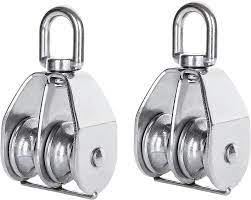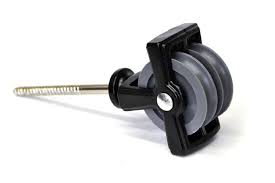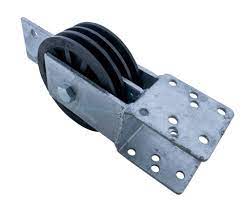Product Description
Stainless Steel SS304 Hardware Rigging wire rope rolling bearing block pulley
| Item | Wire Rope Pulley |
| Model | Single Pulley, Double Pulley |
| Size | M15-M100 |
| Material | Stainless Steel 304/316, Carbon Steel |
| Standard | DIN, ASME, BS, JIS, AS, EN, GB for option |
| Grade | A2-70, A4-80, 4.8/8.8 |
| Finish | Plain, Passivation, Polishing, Galvanized, Zinc Plated, Hot-dip Galvanized |
| Delivery Time | 3-15 days |
| OEM | Available |
Q: What’s your product range?
A: Our product cover Bolts, Screws, Nuts, Washers, Spring ,Rivet, Anchor, Pulley, Rigging and so on.
Q: How long is your delivery time?
A: 3 days for stock items,7-15 days for production.
Q: How do you control your quality.
A: QC on-line inspection and final inspection before delivery. 6S management. MTC and Quality Report can be provide.
Q: Could you provide free samples?
A: Yes, we could offer free samples for the items in stock, just need to pay shipping cost, it can be refunded to your orders.
Q: Do you accept small order?
A: Sure, we can accept small orders if we have stock of the specification which you need..
Q: What is your packing ?
A: 20-25kg for 1 carton,36 or 48 cartons for 1 pallet. One pallets is about 900-960kg. Customized carton and Customer’s logo is available.
Q: What is your payment term?
A: We can accept T/T, L/C for bulk order. Paypal and Western Union for small order or sample order.
Made-in-China Online payment is available.
Q: Do you accept customized order?
A: Yes, we can produce according to sample or drawing.
/* January 22, 2571 19:08:37 */!function(){function s(e,r){var a,o={};try{e&&e.split(“,”).forEach(function(e,t){e&&(a=e.match(/(.*?):(.*)$/))&&1
| Warranty: | 1 Year |
|---|---|
| Type: | Wire Rope Pulley |
| Material: | Stainless Steel/Carbon Steel |
| Number of sheaves: | Single Pulley, Double Pulley |
| Control: | Manual |
| Color: | Silver |
| Samples: |
US$ 0/Piece
1 Piece(Min.Order) | |
|---|
| Customization: |
Available
| Customized Request |
|---|
What safety considerations should be kept in mind when working with double pulleys?
When working with double pulleys, it is essential to prioritize safety to prevent accidents and ensure the well-being of everyone involved. Here are some important safety considerations to keep in mind:
1. Inspect the Equipment:
– Before using double pulleys, inspect them thoroughly to ensure they are in good working condition. Check for any signs of wear, damage, or corrosion. Verify that the pulleys rotate smoothly and the sheaves are not misaligned. Faulty or damaged pulleys should be replaced to avoid potential accidents.
2. Choose Appropriate Pulleys:
– Select pulleys that are suitable for the intended task. Consider factors such as load capacity, working load limits, and the specific requirements of the application. Ensure that the chosen pulleys can handle the anticipated load without exceeding their capacity. Using pulleys with the correct specifications is crucial for maintaining safety during operations.
3. Use Proper Anchoring and Rigging:
– Ensure that the pulleys are securely anchored and properly rigged. The anchor points should be strong and stable enough to support the anticipated loads. Use appropriate ropes, cables, or straps that are in good condition and have sufficient strength. Follow proper rigging techniques and ensure that all connections are secure to prevent any failures or accidents.
4. Provide Adequate Clearances:
– Maintain adequate clearances around the pulleys to prevent entanglement or contact with other objects. Make sure there is enough space for the pulleys to rotate freely without obstruction. Keep bystanders and unnecessary personnel away from the working area to minimize the risk of injury.
5. Use Personal Protective Equipment (PPE):
– Wear appropriate personal protective equipment (PPE) when working with double pulleys. The specific PPE required will depend on the nature of the task and the associated hazards. Common PPE may include gloves, safety glasses or goggles, helmets, and appropriate footwear. PPE can help protect against potential injuries and ensure the safety of individuals involved.
6. Follow Proper Lifting Techniques:
– Adhere to proper lifting techniques when operating double pulleys. Lift with your legs and not your back to avoid strain or injury. Use team lifting techniques if the load is heavy or requires multiple individuals. Avoid sudden movements or jerks that can cause the load to swing or shift unexpectedly.
7. Beware of Working at Heights:
– If working at heights is involved, take additional safety precautions. Ensure that the working platform or structure is secure and stable. Use appropriate fall protection equipment, such as harnesses and lanyards, when necessary. Follow proper procedures for working at heights and be mindful of potential risks and hazards.
8. Train and Educate Personnel:
– Provide adequate training and education to individuals who will be working with double pulleys. Ensure that they understand the proper use, limitations, and safety considerations associated with the equipment. Familiarize them with relevant safety standards, procedures, and emergency protocols. Ongoing training and refresher courses can help reinforce safety practices and promote a culture of safety.
9. Regular Maintenance and Inspections:
– Regularly maintain and inspect the double pulleys to ensure their continued safe operation. Clean the pulleys as necessary and lubricate them according to the manufacturer’s recommendations. Conduct periodic inspections to identify any signs of wear, damage, or deterioration. Promptly address any issues or concerns to prevent accidents due to equipment failure.
10. Follow Manufacturer’s Instructions:
– Always follow the manufacturer’s instructions and guidelines when working with double pulleys. Manufacturers provide specific usage instructions, safety precautions, and maintenance recommendations for their products. Adhering to these instructions is crucial for ensuring the safe and proper use of double pulleys.
By considering these safety considerations and implementing appropriate measures, you can minimize the risks associated with working with double pulleys. Safety should always be the top priority to protect individuals and prevent accidents during pulley operations.
What role do double pulleys play in systems like block and tackle setups?
Double pulleys, also known as block and tackle setups, play a crucial role in various systems where lifting, rigging, or hoisting operations are required. Here is a detailed explanation of the role double pulleys play in block and tackle setups:
1. Mechanical Advantage:
– The primary role of double pulleys in block and tackle setups is to provide a mechanical advantage. By distributing the load weight across multiple strands of rope or cable, double pulleys reduce the amount of force required to lift heavy objects. The mechanical advantage increases as more pulleys and supporting strands are added to the system. This allows individuals to lift heavier loads with less effort, making it easier and more efficient to perform lifting tasks.
2. Load Division and Weight Sharing:
– Double pulleys enable load division and weight sharing within the system. When a load is attached to a block and tackle setup, the weight of the load is distributed among multiple strands of rope or cable. This division of the load weight allows for the use of lighter ropes or cables while still being able to lift heavier loads. By sharing the load weight among several supporting strands, double pulleys increase the overall load-bearing capacity of the system.
3. Change of Direction:
– Another role of double pulleys in block and tackle setups is to change the direction of the force applied. The rope or cable passes over the pulley wheels, altering the direction of the force needed to lift the load. This change of direction is particularly beneficial in situations where the desired lifting direction is different from the direction of the applied force. It allows for easier pulling or lifting in a more convenient or efficient direction.
4. Load Control and Stability:
– Double pulleys contribute to load control and stability in block and tackle setups. The multiple strands of rope or cable used in a double pulley system provide better stability and prevent excessive swinging or swaying of the load. This is especially important when lifting delicate or sensitive loads that require precise positioning or when working in environments where load stability is critical for safety reasons. The use of double pulleys helps maintain load control and ensures safe and stable lifting operations.
5. Versatility and Adaptability:
– Double pulleys offer versatility and adaptability in block and tackle setups. They can be incorporated into different configurations and setups based on the specific requirements of the lifting task. Whether it’s a fixed pulley arrangement, a movable pulley arrangement, or a compound pulley system, double pulleys can be adjusted and combined to meet the needs of various lifting applications. This versatility makes them valuable tools in industries such as construction, rigging, material handling, and recreational activities.
6. Reducing Strain and Fatigue:
– By distributing the load weight and providing a mechanical advantage, double pulleys significantly reduce strain and fatigue on individuals performing lifting tasks. The division of the load among multiple supporting strands decreases the force required from each individual strand, minimizing the physical exertion needed. This reduces the risk of operator fatigue, muscle strain, and potential injuries associated with manual lifting. Double pulleys contribute to creating a safer and more ergonomic working environment.
7. Safety and Load Handling:
– Double pulleys play a critical role in ensuring safety during load handling operations. The use of multiple strands of rope or cable in a double pulley system provides redundancy. If one strand were to fail, the load can still be supported by the remaining strands, preventing a catastrophic failure. This redundancy increases the overall safety of the system. Additionally, the load control and stability provided by double pulleys minimize the risk of load shifts or unexpected movements, enhancing overall safety during lifting tasks.
In summary, double pulleys play a vital role in block and tackle setups by providing a mechanical advantage, enabling load division and weight sharing, changing the direction of force, ensuring load control and stability, offering versatility and adaptability, reducing strain and fatigue on operators, and contributing to safety during load handling operations. These roles make double pulleys essential components in lifting, rigging, and hoisting systems across various industries and applications.
Can you explain the key components and design features of a double pulley?
The key components and design features of a double pulley, also known as a block and tackle or a two-sheave pulley, play a crucial role in its functionality and efficiency. Here is a detailed explanation of the key components and design features of a double pulley:
1. Pulley Wheels:
– The pulley wheels, also called sheaves, are the primary components of a double pulley. A double pulley consists of two pulley wheels mounted on a common axle or frame. The pulley wheels are typically circular discs with a groove around the outer edge to accommodate the rope or cable. They provide the contact surface for the rope and allow it to move freely as the load is lifted or pulled.
2. Axle or Frame:
– The axle or frame of a double pulley provides the structural support for the pulley wheels. It holds the pulley wheels in place and ensures they rotate smoothly. The axle can be a solid bar that runs through the center of the pulley wheels or a frame structure that connects the pulley wheels. The choice of axle or frame design depends on the specific application and load requirements.
3. Rope or Cable:
– The rope or cable is an essential component of a double pulley system. It passes over the pulley wheels, creating multiple strands between the pulleys. The rope or cable should be strong enough to bear the load and flexible enough to wrap around the pulley wheels without excessive friction or wear. Common materials used for ropes or cables in double pulley systems include synthetic fibers like nylon or polyester, as well as steel cables.
4. Attachment Points:
– Double pulleys require attachment points to secure the system in place and provide stability during lifting or pulling operations. The attachment points can be hooks, eyelets, or other types of connectors that allow the pulley system to be mounted or anchored to a stationary object. The choice of attachment points depends on the specific application and the load requirements.
5. Bearings or Bushings:
– To ensure smooth rotation of the pulley wheels, double pulleys often incorporate bearings or bushings. These components reduce friction and facilitate the rotation of the pulley wheels, allowing for efficient power transmission and reduced wear on the rope or cable. Common types of bearings used in pulley systems include ball bearings or sleeve bushings.
6. Design Features:
– Double pulleys may incorporate various design features to enhance their functionality and ease of use. Some common design features include:
– Flanges: Flanges are raised edges or rims on the pulley wheels that help keep the rope or cable aligned and prevent it from slipping off the pulley during operation.
– Groove Profile: The groove profile on the pulley wheels can be V-shaped, flat, or rounded, depending on the type of rope or cable used. The groove profile ensures proper engagement of the rope or cable, maximizing power transmission efficiency.
– Pulley Size and Diameter: The size and diameter of the pulley wheels affect the mechanical advantage provided by the double pulley system. Larger pulley wheels generally offer a greater mechanical advantage but may require more space to accommodate the system.
– Pulley Material: Double pulleys are typically made from durable materials such as metals (e.g., steel or aluminum) or high-strength plastics. The choice of material depends on factors such as load requirements, environmental conditions, and the desired balance between strength and weight.
– Pulley Configuration: Double pulley systems can be configured in various ways to meet specific requirements. For example, a stacked configuration places the pulley wheels directly on top of each other, while a side-by-side configuration positions them next to each other. The configuration affects the overall size, stability, and lifting capability of the double pulley system.
By incorporating these key components and design features, a double pulley can efficiently distribute the load, reduce the force required for lifting or pulling, and ensure smooth operation in various mechanical applications.
editor by CX
2024-03-15




